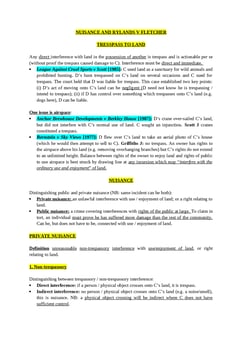Goldman v Hargrave [1967] 1 AC 645; [1966] 3 WLR 513; [1966] 2 All ER 989
Judgement for the case Goldman v Hargrave
Table Of Contents
KEY POINTS
-
In Australia, particularly in Western Australia, legal implications arise in negligence leading to fires, especially those initiated accidentally by lightning. The scope of an occupier's duty of care towards their neighbours is necessary in such scenarios.
The occupier must check and ensure fire prevention or swift containment, addressing the spread caused by their negligence.
Accidental fires ignited by lightning present a unique challenge, and the duty of care extends to the occupier's responsibility to remove or reduce hazards.
The standard of care expected from occupiers is a factor in determining their liability for damages resulting from the spread of fire.
-
The Fires Prevention Act plays a significant role, emphasising that any fire that accidentally begins, especially due to lightning, should be promptly addressed.
The occupier's negligence, leading to the spread of fire, leaves them vulnerable to legal consequences, with no defence available under the Fires Prevention (Metropolis) Act of 1774.
Words and phrases such as "Any fire shall accidentally begin" gain legal importance in interpreting the obligations imposed by the Fires Prevention (Metropolis) Act of 1774 (14 Geo. 3, c. 78), s. 86.
FACTS
The Fires Prevention (Metropolis) Act, of 1774, shields individuals from liability if a fire accidentally begins on their estate.
-
On February 25, 1961, lightning struck a 100-foot redgum tree on Allan William Goldman's (“The Appellant's’) land, igniting a fire.
Despite efforts to clear space and spray water, the tree was cut down on February 26.
However, the Appellant neglected to take reasonable steps to prevent the fire's spread after February 27.
Adverse weather conditions on March 1 revived the fire and damaged neighbouring properties.
The Appellant, though observing the fire, couldn't stop it.
The Supreme Court of Western Australia ruled in favour of the Appellant, stating that no duty existed to extinguish the fire.
-
However, the High Court of Australia disagreed, holding the Appellant liable for damages as removing the tree created a different hazard.
The court imposed a duty to exercise reasonable care, which was neglected.
JUDGEMENT
-
On appeal, it was established that an occupier of land bears a general duty of care for hazards on their property.
This duty requires knowledge of the hazard, foresight of consequences, and the ability to mitigate it, with the standard based on reasonableness in individual circumstances.
While initially prudent in addressing a fire until February 26, the Appellant became negligent in using a method prone to fire revival, which resulted in liability for damages to the respondents.
Interpreting the Fires Prevention (Metropolis) Act, 1774, sensibly, the fire on March 1 was attributed to the Appellant's negligence, rendering the statutory defence inapplicable.
The law acknowledges that an occupier, burdened with an unsought hazard, should only be expected to act reasonably given their individual circumstances.
The High Court of Australia's judgment was affirmed.
COMMENTARY
The legal implications of negligence leading to fires in Australia, particularly in Western Australia. It emphasises the duty of care that land occupiers owe to their neighbours, especially in lightning-induced fires.
The Fires Prevention Act is important in stressing the prompt addressing of fires, with no defence available for occupiers' negligence under the Fires Prevention (Metropolis) Act of 1774.
The case of Allan William Goldman exemplifies a lightning-initiated fire in which the Appellant's negligence caused damage to neighbouring properties.
Legal proceedings revealed a divergence in views between the Supreme Court of Western Australia and the High Court of Australia, with the latter holding the Appellant liable for creating a different hazard.
The subsequent appeal reinforces the general duty of care for land occupiers, stressing knowledge, foresight, and reasonable mitigation efforts.
ORIGINAL ANALYSIS
A tree in Defendant’s garden was struck by lightening and caught fire. He could have put it out with water but, wrongly, believed that the best approach was to let the fire “burn out”. Later on, the wind picked up and spread the fire to Plaintiff’s property which was damaged.
-
Privy Council held that he was liable:
There is a general duty of care of land-owners to prevent hazards on their land harming others.
This duty is based on awareness of the hazard, ability to foresee consequences of not checking or removing it, and the ability to abate the hazard.
The standard of the duty of care required is “what it was reasonable to expect of him in the circumstances.” The justification for the “in all circumstances” qualification is that a person with no resources cannot be expected to tackle a fire as well as a person with a fire hose in their garden, i.e. to impose a purely objective standard of care would be “unjust and unenforceable”.
Lord Wilberforce
A rule which required of him… in his neighbour's interest a physical effort of which he is not capable, or an excessive expenditure of money, would be unenforceable or unjust.
For Further Study on Goldman v Hargrave
Need instant answers? Our AI exam tutor is here to help.
Ask questions 🙋 Get answers 📔 It's simple 👁️👄👁️
Our AI is educated by the highest scoring students across all subjects and schools. Join hundreds of your peers today.
Get StartedSimilar Cases
Related Product Samples
These product samples contain the same concepts we cover in this case.
| Tort Law | Negligence Law Notes (20 pages) |

 Since 2010, Oxbridge Notes has been a trusted education marketplace, supplying high-quality materials from top achievers at universities like Oxford, Cambridge, LSE, Harvard, and Yale.
Since 2010, Oxbridge Notes has been a trusted education marketplace, supplying high-quality materials from top achievers at universities like Oxford, Cambridge, LSE, Harvard, and Yale.